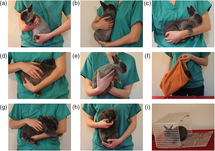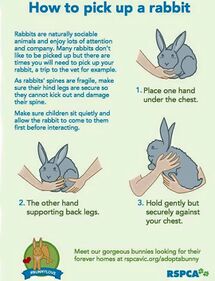Handling
Rabbits are relatively fragile creatures that require proper handling techniques to restrain. Because their spine is relatively brittle compared to their strong back legs, panicked struggling can lead a rabbit to break their own back when kicking out if the rabbit is not properly and securely held. Fractures in the vertebral column can easily occur especially if the hind legs are not restrained properly during handling.[1]:254 Rabbits have a high muscle-to-bone ratio -- 12-13% of the body weight is comprised of bone in a cat, but only 7-8% is bone in the rabbit.[2][3] The skeleton of New Zealand white rabbits represents approximately 6-7% of the total body weight, while the skeletal muscle constitutes over 50% of their body weight.[1]:254
Most of the time, rabbits like it best when all four feet are on the ground. Let your rabbit come to you for attention rather than going after them to force cuddling. Rabbits are prey animals and being lifted off the ground instinctively gives them the feeling of being captured by a predator. However, it is still important that your rabbit learn to tolerate handling for necessities such as going to the vet, giving medication, or trimming their nails.
How do I transport my rabbit if I can't pick them up?
Please also see the Handling FAQ question "How do I catch my rabbit to put them in a carrier?"
How do I properly hold my rabbit?

Never pick your rabbit up by the scruff of their neck or their ears. The scruff may be used to grasp a rabbit to hold the bunny still against the ground before scooping up their hindquarters, but the skin on their neck is too fragile to completely support a rabbit's weight. Rabbits are not cats, and it is incredibly painful for your rabbit to be held this way.
The most popular way of picking a rabbit up is by holding one hand on the chest of the rabbit between the front legs and using the other hand to support the rabbit's bottom. As soon as the rabbit is lifted from the ground, they should be held tightly to the chest.
When placing a rabbit back down to the ground, the rabbit should be turned toward the handler's body so that the bottom is the closest to the ground. Very often, a rabbit will wriggle, squirm, and kick off if they sees the ground incoming to be back on the floor faster.
If a rabbit continues to wriggle or squirm regardless of how they are held or picked up, it is very important not to put the rabbit down before they calms themselves, or the bunny will learn to consistently be hard to handle.
If you have difficulty catching a rabbit to be picked up, you can throw a large blanket or towel over the rabbit to trap them before tightly wrapping them in a bunny burrito for handling.
The following are some helpful videos about safe rabbit handling:
Teaching a rabbit to accept handling
Unless your rabbit has been well-handled as a baby until you took them home, your rabbit will most likely not appreciate being grabbed and picked up in your arms. As a result, to decrease the amount of stress the rabbit will undergo, we recommend that you train your rabbit to tolerate handling in gradual steps.
- Start with your rabbit on the floor and get them used to you touching their body everywhere, especially on the belly and around the bottom. This can be a part of your daily petting and grooming sessions with your rabbit so that your rabbit will not feel that being touched under the chest around their behind is associated only with being picked up. If at any point the rabbit runs away, do not chase after them. Lure the rabbit back to you with treats. The rabbit will be much more relaxed about tolerating your touching if they that they can get away at any point.
- When the rabbit does not mind being touched under the belly or around their behind, begin placing your hand underneath their front arms and gently lifting while petting. The rabbit's back feet should still be firmly planted on the ground at this point. Keep the height very low to start with and increase the height as the rabbit gets more and more used to the procedure. Like before, if at any point the rabbit jumps away, do not chase them and force more handling upon them. If your rabbit doesn't seem to like any support on their chest, try gently resting your hand on their chest, then raising a treat upwards in your other hand so your rabbit naturally lifts their front feet to reach. Keep your hand in position as your rabbit moves so you are just supporting their movement and not making the lift.
- Next, try to lift your rabbit's back end. Keep your rabbit's front paws grounded on the floor this time. Cup your hand around your rabbit's behind, and gradually support more and more weight until their feet are off the ground. Don't lift more than a little off the ground as you don't want your rabbit to feel like it's doing a forward roll.
- Once your rabbit is comfortable with both processes, try gradually lifting your rabbit completely. Place one hand under their front arms and the other to support their hindquarters. If your rabbit is small enough, you can also place a thumb around their shoulders for more support. Start with just supporting your rabbit's weight in your hands and then only lifting an inch off the floor. Place the rabbit back to the floor immediately in the beginning before they begin to struggle. Treat after putting them back on the floor. If the rabbit is already struggling, wait until they stop, then place down. Go back to the previous step if a successful lift is difficult.
- Slowly start lifting your rabbit higher and higher and move the rabbit around in your hands. Hold the rabbit with their head slightly higher than their bottom with the bottom slightly tucked in. This will prevent the rabbit from kicking out backwards or trying to do a forward somersault.[4] Use quick and confident movements to scoop the rabbit to be held. If you are nervous, your rabbit will detect it, and they will be nervous, too. As before, if the rabbit begins to struggle, wait until they stop, then place back on the floor before giving a treat.
- When you can easily hold your rabbit in your hands without struggling, start to bring the rabbit to your lap. Hold them securely next to your body while petting and talking to them. Continue to reward for every successful handling and wait for any struggling to stop before placing them down.
- When your rabbit is comfortable being held in your lap, increase the stakes by beginning to slowly stand up while holding your rabbit. Hold your rabbit close to your body for a firmer hold to prevent accidental escape. Treat and put them back on the floor like the previous steps.
Have these training sessions short and dispersed but repeat them often. Make sure that you don't try to only handle your bunny whenever you approach it, or they will slowly learn to become hand-shy. Have positive experiences such as just as feeding food and petting sessions in between these handling sessions. Your rabbit should slowly learn to tolerate handling once they realize the process will cause no harm. Do note that each bullet may take days, weeks, or even months, but it's okay! Gaining the trust of your rabbit is no small task.
Further reading
- Kinenchen. (2014). Handling your Rabbit
- Kathy Smith. (2003). Proper Handling [PDF]
- The Rabbit House. Rabbit Behaviour Problem: My Rabbit Hates Being Picked Up
- Rabbit Rehome. How to Pick Up Your Rabbit
- MediRabbit. Safe carrying of a rabbit
- Happy Hoppers Rabbit Forum. (2011). Handling, Lifting & Transporting Rabbits
- Guen Bradbury. (2016). Getting to grips with correct rabbit handling [PDF]
- A.G. Bradbury and. G.J.E. Dickens. (2016). Appropriate handling of pet rabbits: a literature review
- Carolina James, Picking Up a Rabbit
- Carolina James. (1999). Taking Out and Putting a Bunny Back to Their Cage
- Holly O’Meara. (1998). An Uplifting Experience
See also
References
- ↑ 1.0 1.1 Percy, D. H., & Barthold, S. W. (2007). Pathology of laboratory rodents & rabbits. (3rd ed.).
- ↑ Ballard, B & Cheek, R. (2010). Exotic Animal Medicine for the Veterinary Technician. (2nd ed.).
- ↑ Quesenberry, K & Carpenter, J. (2012). Ferrets, Rabbits, and Rodents: Clinical Medicine and Surgery. (3rd ed.).
- ↑ Rabbit Rehome. (2009). How to Pick Up Your Rabbit. Retrieved 07 March 2016 from http://www.rabbitrehome.org.uk/care/handling.asp


